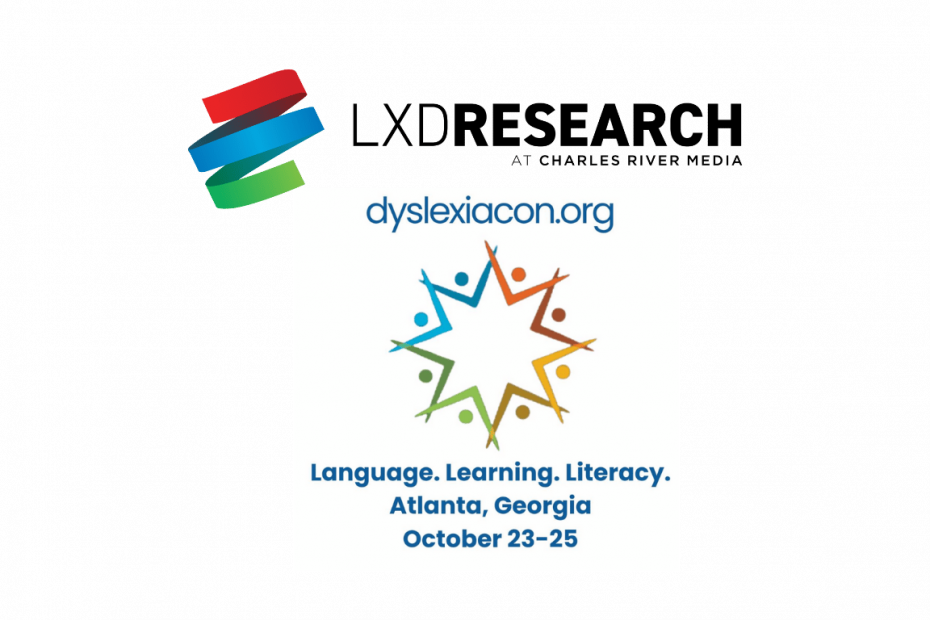Last weekend at the International Dyslexia Conference, I found myself returning again and again to a single insight that seemed to weave through every conversation, every poster session, every hallway chat: the connection between language and reading runs deeper than much of our research has acknowledged.
Standing at our two LXD Research posters with my colleague or presenting our findings on the Walk to Read model with 95 Percent Group, I kept thinking about how our field is evolving. We’re moving beyond simply asking “does it work?” and digging into the more complex questions of how, why, and for whom these interventions make a difference.
Presenting Our Research
Our presentation focused on multiple studies across grades K-5 that utilized the Walk to Read model, examining the impact of schools committing to small-group, structured literacy in various contexts and settings. The longitudinal nature of this work matters—not just for the sake of rigor, but because it reveals something essential about the key ingredients for success in small-group instruction. Laura Stewart, former leader of the Reading League and a district leader from Fulton County, joined me on stage with the Director of Research from 95 Percent Group to share what the recipe for Walk to Read looks like. Email Rachel if you’d like a copy of our slides.
LXD Research also had two research posters on Saturday – alongside researchers who were cited in our own papers! We shared findings on the outcomes of adaptive technology using MindPlay Reading Coach. In the area of EdTech, LXD Research continues to push for evidence that can actually inform practice rather than just check compliance boxes. The other study focused on whole-school teacher training and coaching using Spalding’s Writing Road to Reading, which demonstrated dramatic differences in reading proficiency among the schools, highlighting the benefits of a whole-school investment compared to piecemeal approaches.
The questions we fielded from educators and administrators reminded me why this work matters. They wanted to know: Will this work with my multilingual learners? How do we maintain fidelity when teachers are already stretched thin? What does implementation actually look like in a Title I school?
Early Language as Foundation
One of the most compelling sessions I attended explored multilingual learning and its implications for literacy instruction. Presenters throughout the event emphasized early language development as foundational—not just as a predictor of later reading success, but as the actual architecture upon which reading comprehension is built. This wasn’t a new concept, exactly, but the way it was framed felt urgent and clarifying.
We often talk about the “reading rope” and acknowledge that language comprehension is half the equation. But this session pushed further, examining how oral language proficiency, vocabulary depth, and syntactic awareness in early childhood create the cognitive infrastructure that students need when they encounter increasingly complex texts in third grade and beyond. For multilingual students, the picture becomes even more nuanced—and the need for intentional, research-informed instruction even more critical.
It reinforced something I’ve been thinking about in our own research: we need to be looking earlier and looking more closely at language development if we want to understand why some interventions work better for some students than others.
Connecting Across the Field
Beyond our own presentation, the real value of the conference was in the conversations between sessions. We connected with clients who are wrestling with real implementation challenges in real classrooms. We learned from researchers asking different questions than we are, which always makes our own questions sharper. And we saw the thoughtful work that organizations like EPS Learning, MindPlay, ROYO, IMSE, Objective Ed, Spalding, Tumbleweed, and Read Bright are bringing to educators.
There’s something energizing about being in a room with people who understand that evidence isn’t just about proving what works—it’s about understanding how and why and for whom. The field is evolving, and conferences like this one are where you can actually feel that evolution happening in real time.
Why This Matters
The dyslexia and structured literacy community has always been ahead of the curve in understanding that reading difficulties aren’t a failure of effort or intelligence, but a difference in how brains process language. What feels different now is the growing recognition that early oral language development—before children ever crack open a book—may be one of our most powerful levers for intervention.
This has implications for how we design studies, what outcomes we measure, and when we start looking for signs that a student might benefit from additional support. It also has implications for how we think about professional development for early childhood educators, who are often working with students years before reading difficulties become visible.
As I packed up our tablecloth and brochures at the end of the conference, I felt grateful. Grateful for the researchers, educators, and product developers who are committed to getting this right. Grateful for the clients who trust us to evaluate their work honestly and rigorously. And grateful for the reminder that this work—messy and complex as it is—matters deeply for students who deserve evidence-based instruction that meets them where they are.
If you were at the conference, I’d love to hear what resonated with you. And if you couldn’t make it this year, I hope these reflections offer a glimpse into the conversations that are shaping the future of literacy research and practice.



